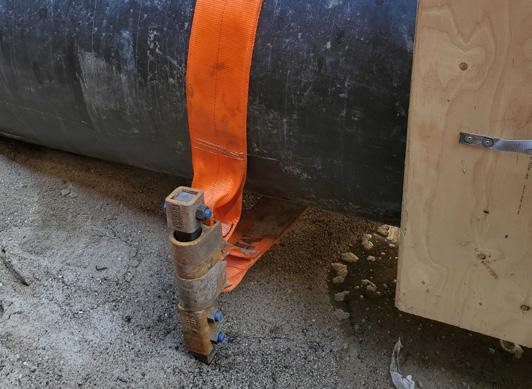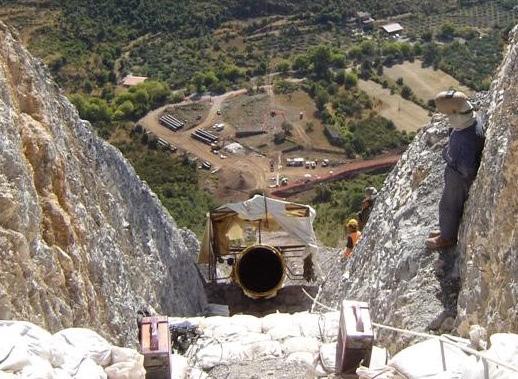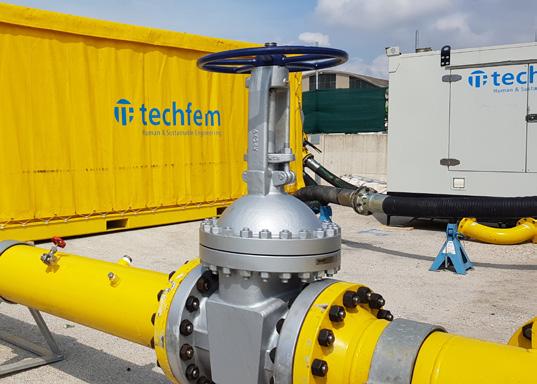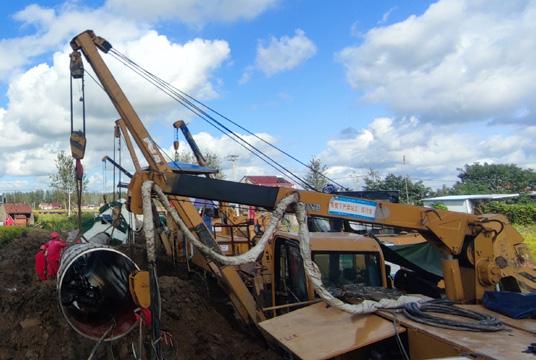
8 minute read
Member News
from IPLOCA Newsletter 91
by Pedemex BV
Cyntech’s Anchor System in Baltic Pipe Project
Cyntech is proud to share its involvement with the ongoing construction of the Baltic Pipeline. The watercourse crossings on this project present unique challenges; Cyntech’s pipeline anchor system was chosen as the technology to solve these challenges and ensure safe constructability and operation of the Baltic Pipeline. In addition to providing superior stabilisation of the pipeline, Cyntech’s anchor system reduces the project’s carbon footprint by eliminating hundreds of tons of concrete and replacing it with high-strength, recycled steel.

Goriziane E&C’s Pipe Facing Machines can be used for the construction of oil, gas and water pipelines. The company is able to design and manufacture custom-made machines as per each customer’s needs, such as the double pipe facing machines, or miter pipe facing machines with mitered bevels up to 2°, where mitered pipe is required. The Pipe Facing Machine ranges from 6’’ up to more than 88’’, makes precise bevels (+/- 0,1mm), has an adjustable rotation speed with a safety system, and is low maintenance. If required, it can also bevel up to 2° without using a Pipe Bending Machine. In addition to its pipe facing machines, Goriziane is now offering the first ever Fully Electric Bevelling Machine with a single expansion group, able to cover the complete pipe range. It has an adjustable bevelling speed, maximum torque, high-force clamping and is able to re-round pipes. It also has a wireless control function, allows for the possibility of installing a 3D scanner for bevelling control, and is equipped with IoT for remote assistance.
ILF Supports the Baltic Pipe Project
ILF is proud to support the Jutland Funen project, part of the overall Baltic Pipe project, with engineering services including, amongst others, project management, detailed design, owner’s engineer, and construction supervision. The Baltic Pipe project is a major gas infrastructure project that aims at creating a new supply corridor in the European gas market. For the first time ever, it will enable shippers to flow gas directly from Norway to the markets in Denmark, Sweden, and Poland, together with their neighbouring markets. Moreover, it will also enable shippers to flow gas bidirectionally from Poland to the Danish and Swedish markets, thus further strengthening supply diversification, market integration, price convergence, and security of supply. The project is expected to be commissioned by October 2022 and gain full capacity by 31 December 2022. In view of the Russian decision, at the end of April, to stop delivering contracted amounts of gas to Poland, the Baltic Pipe project proves to be an excellent investment and ensures that not only Poland but also Lithuania and potentially Slovakia are going to gain full independence from politically used gas supplies.
KPTL Oil & Gas Pipeline Business Awarded Major Pipeline Projects in India
In August 2021, Kalpataru Power Transmission Limited (KPTL) was awarded the laying & construction of a steel gas pipeline and terminals along with associated facilities for

Section II of the Mumbai – Nagpur Pipeline Project (Part A) for GAIL (India) Ltd. This contract covers the laying, testing, pre-commissioning, and commissioning of a 24” x 226.6 km pipeline including seven Sectionalising Valve Stations and two Intermediate Pigging Stations. In January 2022, KPTL was awarded the contract for the laying of an iron ore slurry pipeline (Spread I) from Palashpanga to Jajpur for JSW Utkal Steel Ltd., at Odisha Mines, covering laying, testing, precommissioning, and commissioning of a 32” x 131 km slurry pipeline including five Pressure Monitoring Stations. Both projects involve construction management, HSE & quality management, surveying, ROU management, crossings and HDD along the pipeline route, laying of OFC & HDPE ducts, site restoration, magnetic cleaning and EGP (Electronic Geometric Pigging) of the pipeline, temporary cathodic protection works, associated civil, electrical, instrumentation and telecom works.
Increased Efficiency Onsite with Latest Liebherr Dozer Assistance Systems
Liebherr generation 8 dozers offer a variety of operator assistance systems to optimise the entire site process from preparation up to completion. With Liebherr Indicate, operators see the inclination of terrain as well as blade and machine position (longitudinal and cross slope) in one glance. This allows them to quickly have an overview of the situation onsite, to shorten preparation time and to use the machine technology more efficiently. The active blade stabilisation, Liebherr Free Grade, supports drivers to quickly create precise gradings. Without the need for a surveyor or digital site models, the creation of access roads and unloading areas, storage and service places is done with ease. Liebherr Definition Grade, the active blade guidance, expands the possibilities to the next level. This assistance system allows to model a 2D surface without a rotating laser and can be used as a fallback solution when no global navigation satellite system (GNSS) is available. Equipped with Liebherr Ready Kits for machine control systems of Trimble, Topcon or Leica, customers are able to increase productivity and get complex jobs done in fewer passes, while keeping setup and installation time to a minimum.

LogIC’s Pipeline Construction Digitalised Quality Management

Throughout pipeline construction, operations must be controlled with evidence to ensure traceability, quality and compliance with requirements. Necessary activities are carried out by field teams and a significant quality team but, thanks to LogIC’s QCM application they can be digitalised. Set with requirements and all project input data (users, allowed ranges, materials, pipe list, etc.), the application, used by team leaders in the field with a tablet, collects, controls and transmits construction data for each activity configured specifically before. This allows the quality team to receive, in real time, all the construction data already checked. In this way, field and quality team activities are optimised: no more paper, reduced travel to communicate construction data and sources of errors are removed. The application generates output data needed for the project in real time, such as the weld book and welding statistics, self-checks, reports and progression by activity. All input and output data can be customised at will. With this efficient quality management system, construction follow-up is optimised (cost reduction, real time, geolocalisation, safety and environmental impact) and requirements compliance is improved (data available in real time, data secured, instantaneous communication etc.).
SICIM Awarded Major Pipeline Project in Italy
Having been awarded the construction of 4 lots of the Ravenna – Chieti gas pipeline by Snam Rete Gas, SICIM is returning to its origins and is back in the Italian pipeline construction market after 15 years. The project is located along the Adriatic coast and crosses 3 regions: EmiliaRomagna, Marche, and Abruzzo. Under Snam’s general investment programme, aimed at maintaining the security and quality levels of the national gas transport network,

SICIM will install 175 km of 26” gas line to replace the existing infrastructure built in the 1970s. The pipeline route crosses the coastal “Riviera Adriatica” just outside Ravenna and Rimini and then the hills of central Italy, and entails several complex technological challenges. The presence of roads, railways, and rivers crossings will lead to laying more than 20% of the pipeline length (i.e., approx. 44 km) by using trenchless technologies such as 24 microtunnels, 40 HDDs, and more than 200 auger borings. The work includes the installation of 31 associated above ground installations and approximately 56 km of minor pipeline interconnections with sizes of between 4” and 10”. Once the new pipeline will be commissioned and in operation, the old line is to be removed and steel pipes disposed of. The work will start during the summer of 2022, to be completed within a 36-month period, employing approximately 400 people. As with all of its projects, after completion of the replacement, Snam will take care to restore the natural ecosystems affected by the works.
Baltic Pipe Project’s Pre-commissioning Operation by Techfem

The Baltic Pipe Project, developed by both GAZ-SYSTEM S.A. and Energinet, Denmark as co-investors, is a 36” offshore pipeline, which will connect the east coast of Denmark and the northern coast of Poland. The project involves the construction of a new bi-directional gas pipeline system that will enable shippers to flow gas directly from Norway to the markets in Denmark and Poland. In 2021, Techfem was awarded, as Saipem’s contractor, the execution of the pre-commissioning operations of the ca.275 km offshore pipeline from Denmark to Poland, with a maximum depth of 55 m. The site operations included the following five phases: flooding, cleaning and gauging with filtered and treated seawater; hydrostatic strength test of the pipeline; pipeline desalinisation with fresh water; dewatering by means of dry compressed air; final drying and packing for pipeline preservation until the first gas injection. To date, Techfem has successfully executed the activities concerning the first two phases. The remaining activities are planned to be completed in the coming months.
Xionggu Automatic Welding Machine Spreads Set Inherent Record in LNG Pipeline Project

The Binhai LNG project is located in the northeast of the Subei faulted basin in the Yangtze fault block area. The strata are well developed and a set of shallow marine, coastal and continental materials is deposited there. The Quaternary sedimentary thickness is about 150m. The ground elevation is generally between 0.6m and 9.8m. According to the ground elevation (zero point of waste Yellow River), the whole county can be divided into three types: high elevation land, sub highland and low-lying polder area. There is a large population, a wide water network, complex road crossings and discontinuous pipeline laying surfaces in the area. Sichuan Oil Engineering & Construction Co., Ltd. (CNPC group) utilises 5 spreads of Xionggu A-806/36 internal welding machines and A-610 dual torch pipeline automatic welding machines in this project. With the exception of the fourth spread that has no welding work, there were 56 welded joints per day in the first spread, 55 in the fifth spread, and 24 in each of the second and third spreads, with a total number of welded joints per day of 159. This is a new record set by Sichuan Oil Engineering & Construction Co., Ltd. on the terrain of a wide water network.










